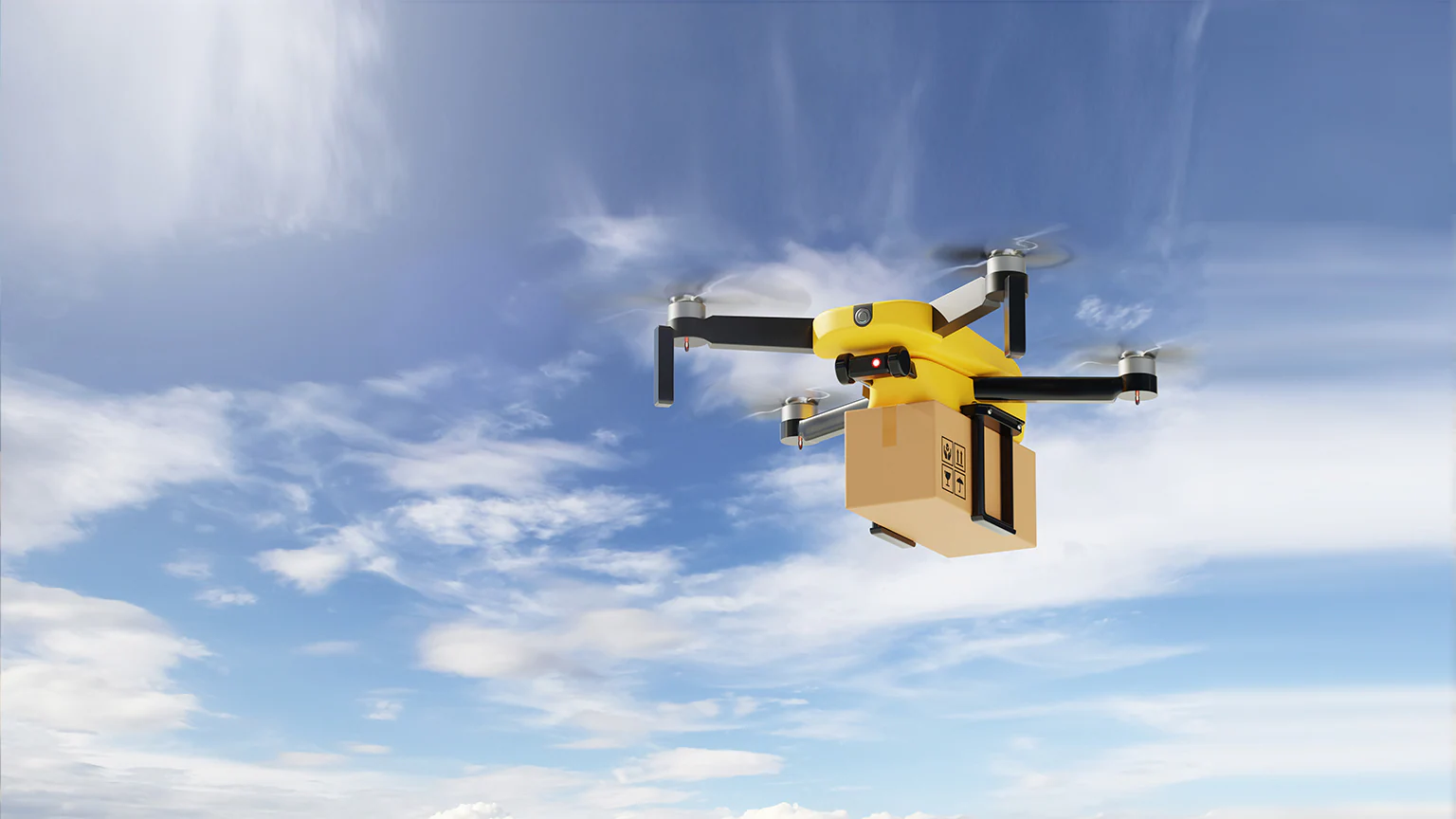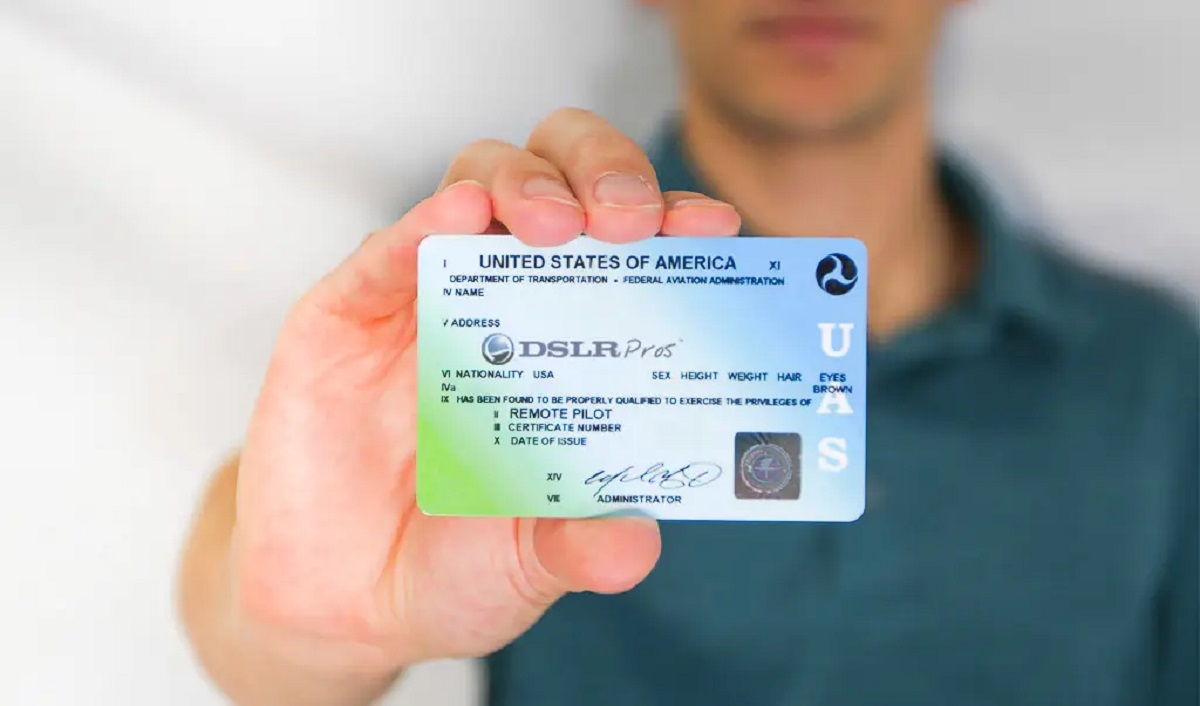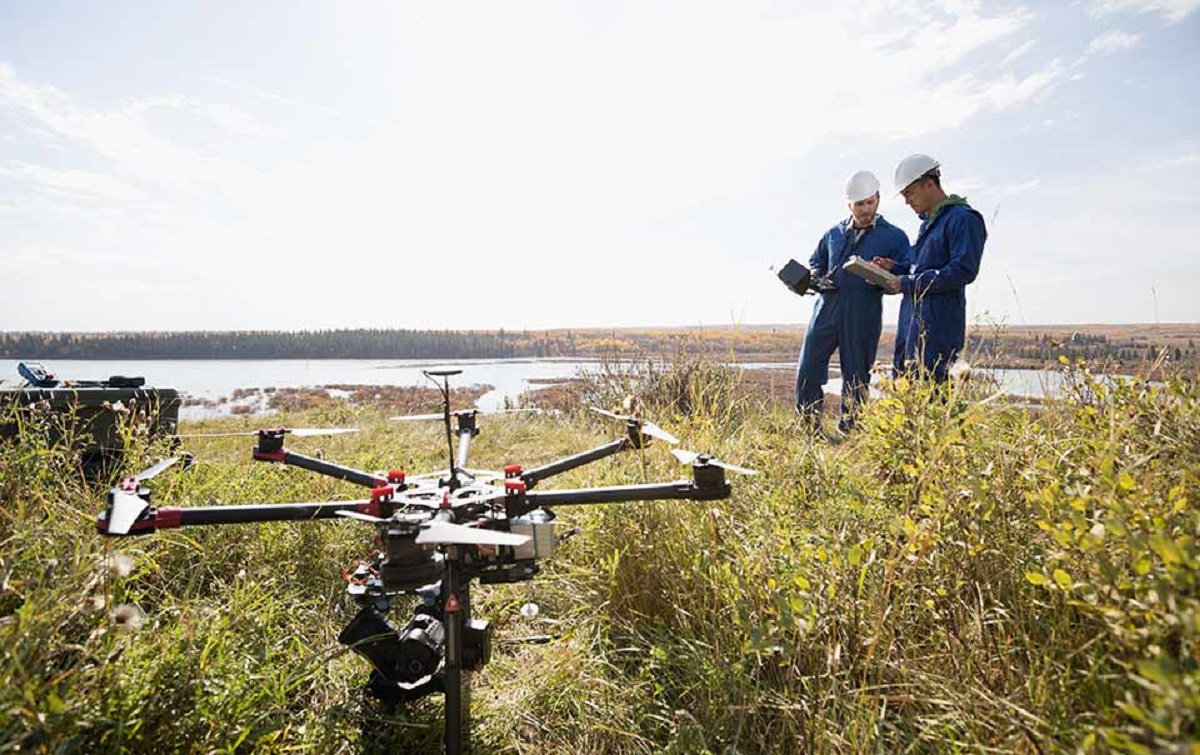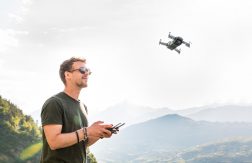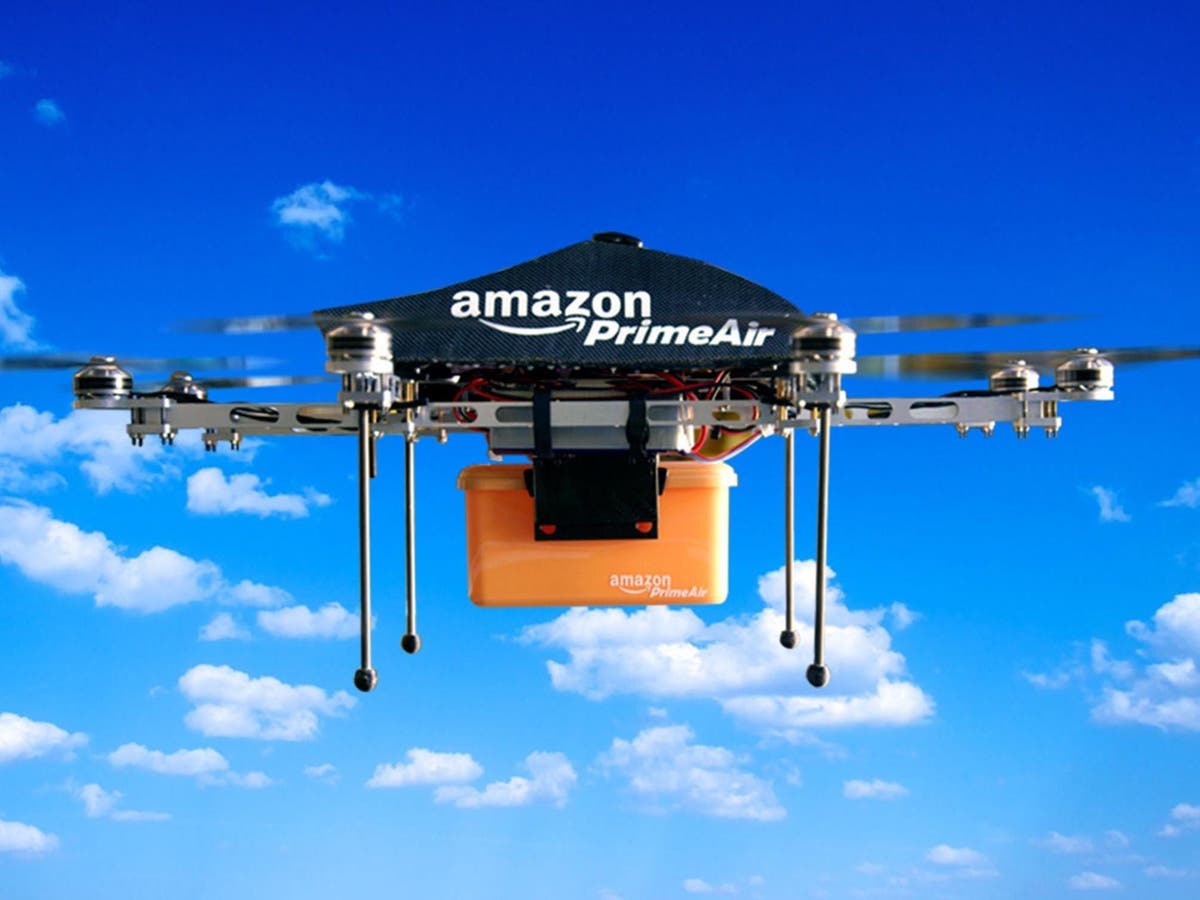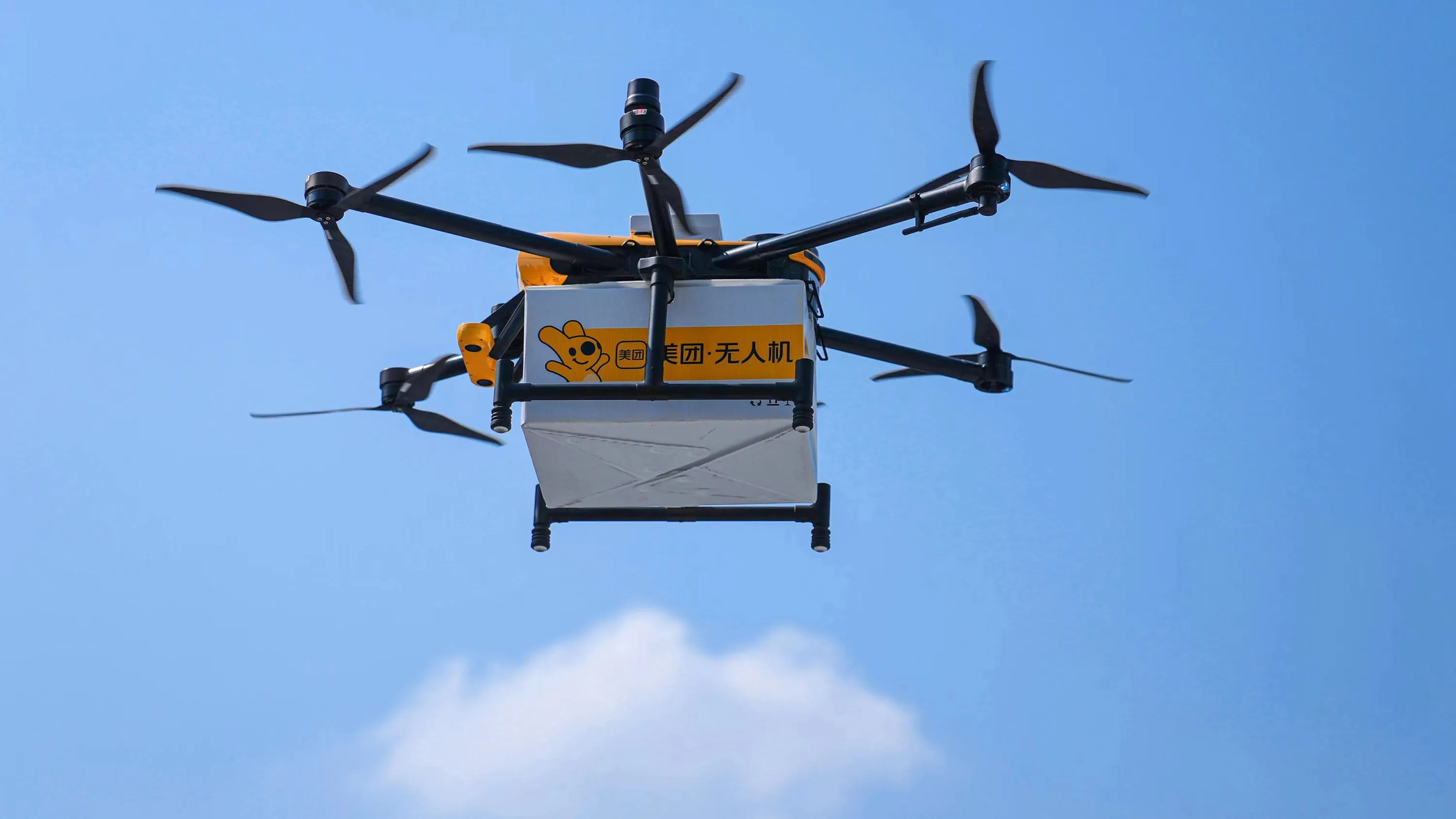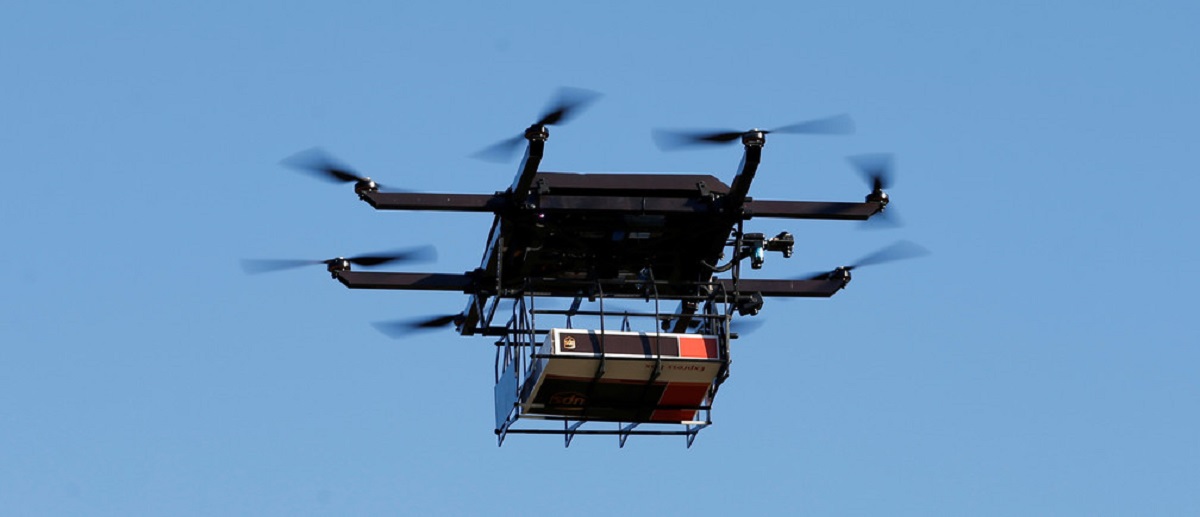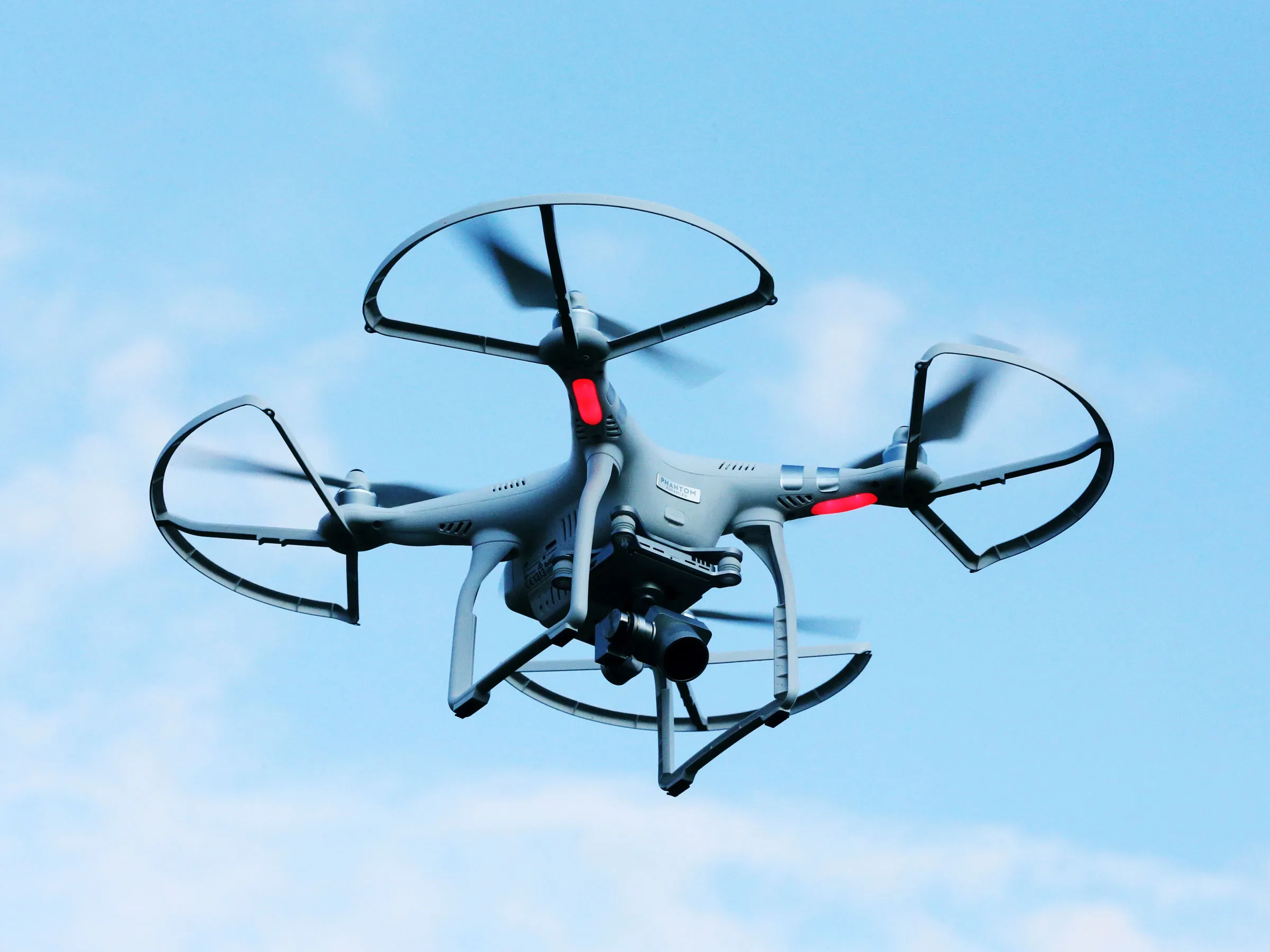Introduction
Drone delivery, once considered a futuristic concept, has now become a reality. This innovative technology is revolutionizing the way goods are transported, offering numerous benefits and possibilities for businesses and consumers alike.
Imagine ordering a product online and having it delivered right to your doorstep within hours, bypassing traffic congestion and traditional delivery methods. Drone delivery makes this possible, providing a faster and more efficient way to transport goods.
With the rise of e-commerce and the increasing demand for fast and convenient delivery options, companies are turning to drone technology as a solution. Drones, also known as unmanned aerial vehicles (UAVs), are small aircraft that are remotely controlled or can operate autonomously.
The growth of drone delivery has been fueled by advances in technology, such as improved batteries for longer flight times, advanced sensors for obstacle avoidance, and more precise navigation systems. These advancements have made drone delivery not only feasible but also safe and reliable.
This article will delve into the world of drone delivery, exploring its history, how drones fly, the components of a drone delivery system, the role of GPS in drone delivery, safety measures and regulations, challenges and limitations, examples of companies using drone delivery, and its potential future impact.
By the end of this article, you will have a comprehensive understanding of how drone delivery works and the potential benefits it holds for various industries.
History of Drone Delivery
The concept of using drones for delivery purposes is not new. In fact, the idea of unmanned aircraft delivering goods dates back to the 19th century. However, it wasn’t until recent years that significant advancements in technology and regulatory frameworks paved the way for the commercial implementation of drone delivery.
The first recorded instance of drone delivery can be traced back to 2012 when a team of students from the Swiss Federal Institute of Technology successfully transported a package using a small quadcopter drone. This groundbreaking experiment sparked widespread interest and laid the foundation for further exploration of drone delivery capabilities.
In 2013, Amazon made headlines by announcing its ambitious plan to introduce Prime Air, a delivery system that uses drones to transport packages to customers’ doorsteps within 30 minutes. While this vision is yet to become a widespread reality, it served as a catalyst for other companies to explore the possibilities of drone delivery.
Since then, numerous companies, including Google’s Wing, UPS, and DHL, have been actively developing and testing their drone delivery systems. These companies have conducted extensive pilot programs and trials in various locations around the world, aiming to demonstrate the feasibility and reliability of drone delivery.
Legislative and regulatory bodies have also been playing a crucial role in shaping the history of drone delivery. In 2016, the Federal Aviation Administration (FAA) in the United States implemented new rules and regulations for commercial drone operations, making it easier for companies to obtain the necessary permissions and licenses to use drones for delivery purposes.
Furthermore, countries like Rwanda and Ghana in Africa have been at the forefront of embracing drone deliveries for crucial medical supplies, bypassing the challenges of traditional transportation infrastructure. These initiatives have showcased the potential of drones in saving lives and providing essential services in remote and underserved areas.
Although the history of drone delivery is relatively short, it has already made significant strides, with more companies and organizations investing in research and development to overcome the challenges and make drone delivery a mainstream reality.
In the next section, we will explore how drones are able to fly and navigate, which is essential for understanding the mechanism behind drone delivery systems.
How Do Drones Fly?
Understanding how drones are able to fly is fundamental to grasping the mechanics behind drone delivery. Drones, also known as unmanned aerial vehicles (UAVs), utilize a combination of aerodynamics, propellers, and flight control systems to achieve and maintain flight.
The primary force that allows drones to fly is lift, which is generated by the movement of air over the wings or propellers. Drones typically employ rotor blades to create lift, similar to helicopters. These rotors, powered by electric motors or combustion engines, spin at high speeds, creating a downward thrust to counteract the force of gravity and lift the drone off the ground.
Unlike conventional aircraft, which use a fixed-wing design for lift and propulsion, drones are often designed with a multirotor configuration. The most common multirotor configurations are quadcopters, which have four rotor blades, and hexacopters or octocopters, which have six or eight rotor blades respectively. The individual rotors can be independently controlled, allowing the drone to maneuver in different directions and maintain stability.
Flight controllers play a crucial role in governing the movement of drones. These electronic devices receive input from various sensors, such as accelerometers, gyroscopes, and magnetometers, to gather information about the drone’s orientation, speed, and altitude. Based on this data, the flight controller adjusts the speed and direction of the rotors to stabilize the drone in the air and execute precise movements.
In addition to lift and flight control, drones also rely on propulsion systems to move forward, backward, or sideways. By adjusting the speed and tilt of the rotors, drones can generate thrust in different directions and achieve controlled flight. This maneuverability is essential for drone delivery, as it allows for precise navigation and delivery to specific coordinates.
It’s worth noting that the flight capabilities of drones are not limited to manual control. Autonomous flight is an integral feature of many modern drones, enabling them to follow preprogrammed routes, track moving objects, or respond to specific commands. This level of autonomy is crucial for efficient and safe drone delivery operations.
Now that we understand how drones fly, let’s explore the components that make up a drone delivery system in the next section.
The Components of a Drone Delivery System
A drone delivery system is composed of various components that work together to ensure the successful transport of goods from a distribution center to the intended destination. These components encompass the drone itself, the payload, the ground control station, and the communication systems.
At the core of the drone delivery system is the drone or unmanned aerial vehicle (UAV). Drones used for delivery purposes are typically equipped with multiple rotors (quadcopters, hexacopters, or octocopters) to provide stability and maneuverability. They are also equipped with advanced flight control systems, sensors, and GPS technology for accurate navigation and precise delivery.
The payload refers to the cargo or items being transported by the drone. Depending on the application, the payload can range from small packages, medical supplies, or even food deliveries. Payload capacity and design need to be carefully considered to ensure the safety of the drone and the integrity of the goods during transit.
The ground control station is where the drone operations are monitored and controlled. It consists of a computer or mobile device that communicates with the drone through a wireless connection. The ground control station allows the operator to input flight plans, monitor the drone’s position, receive real-time feedback from the drone’s sensors, and make necessary adjustments during the delivery process.
Communication systems play a vital role in drone delivery operations. Real-time communication between the drone and the ground control station is essential for coordination, monitoring, and ensuring the safety of the delivery process. Communication systems enable the transmission of commands, telemetry data, and other relevant information between the drone and the control center.
Another key component of a drone delivery system is the navigation and positioning system. Most drones rely on GPS (Global Positioning System) technology to navigate autonomously and locate their position with high accuracy. GPS provides the necessary information to plan the routes, track the progress of the delivery, and ensure the drone reaches the destination safely.
Furthermore, drones used for delivery often incorporate additional safety features, such as obstacle detection and avoidance systems. These systems use sensors such as cameras, LiDAR (Light Detection and Ranging), or ultrasonic sensors to detect and avoid obstacles in the drone’s flight path, ensuring safe and collision-free operations.
The integration of these components into a seamless and efficient system is vital for the success of drone delivery. Companies striving to implement drone delivery services must carefully select and optimize each component to ensure reliable, secure, and efficient operations.
In the next section, we will explore the role of GPS technology in enabling and enhancing drone delivery systems.
The Role of GPS in Drone Delivery
GPS (Global Positioning System) plays a critical role in enabling and enhancing the efficiency of drone delivery systems. This satellite-based navigation system provides accurate positioning and timing information that is essential for drones to navigate autonomously, plan routes, and facilitate precise deliveries.
One of the key advantages of GPS is its ability to provide precise location data to the drone. By receiving signals from multiple satellites, the GPS receiver on board the drone can calculate its exact position in three dimensions (latitude, longitude, and altitude). This information allows the drone to accurately determine its starting point, destination, and intermediate waypoints, forming the basis for efficient route planning.
Route planning is a crucial aspect of drone delivery operations, as it impacts the speed, safety, and efficiency of the delivery process. GPS enables drones to automatically calculate the optimal routes based on factors such as distance, airspace restrictions, and weather conditions. By leveraging GPS data, drones can avoid obstacles, congested areas, and restricted airspace, ensuring smooth and timely deliveries.
Real-time positioning information from GPS also enables drones to maintain their position and track their progress during the delivery. By comparing their current position with the desired path, drones can make adjustments to their flight path, speed, and altitude to stay on course and reach the destination accurately. This capability ensures the successful completion of deliveries, even in varying wind conditions or unexpected environmental factors.
In addition to navigation, GPS synchronization is crucial for coordinating multiple drones involved in simultaneous deliveries. By synchronizing their internal clocks with GPS time, drones can precisely time their departure, arrival, and handover of payloads, allowing for seamless integration and collaboration in a drone delivery network.
Moreover, GPS enhances the overall safety and reliability of drone delivery systems. It provides information on the status of surrounding airspace, temporary flight restrictions, and weather conditions, enabling drones to make informed decisions and adjust their flight plans accordingly. This helps avoid potential collisions, unauthorized intrusions, and other potential hazards during the delivery process.
While GPS is the primary navigation system for drones, it is important to note that it may have limitations in certain environments. Dense urban areas, tall structures, and natural obstructions can interfere with GPS signals, affecting the accuracy and reliability of positioning information. In such cases, drones may employ alternative positioning technologies, such as visual-based navigation or additional sensors, to complement GPS and ensure uninterrupted and precise delivery operations.
With the continuous advancement of GPS technology and the increasing availability of satellite systems like GLONASS, Galileo, and BeiDou, drones will have access to even more accurate positioning data, further enhancing the capabilities of drone delivery systems.
In the following section, we will explore the safety measures and regulations that govern drone delivery operations.
Safety Measures and Regulations for Drone Delivery
As the popularity of drone delivery continues to rise, safety measures and regulations play a crucial role in ensuring the responsible and secure operation of these unmanned aerial vehicles (UAVs).
One of the primary concerns regarding drone delivery is the potential risk of collisions with manned aircraft. To mitigate this risk, aviation authorities worldwide have implemented regulations that establish specific operating limitations for drones. These limitations include restrictions on maximum altitude, distance from airports, and the requirement for drones to maintain a safe separation from other aircraft.
In addition to airspace regulations, governments and regulatory bodies also impose requirements regarding the qualifications and certifications of drone operators. In many countries, individuals operating drones for commercial purposes are required to obtain a remote pilot license or undergo specific training and testing to ensure they possess the necessary knowledge and skills to operate drones safely and responsibly.
Another critical safety measure for drone delivery is the implementation of geo-fencing technology. Geo-fencing involves creating virtual boundaries using GPS or other positioning systems to prevent drones from entering restricted or prohibited areas. These virtual barriers can be applied to airports, military installations, or other sensitive locations to prevent unauthorized access and reduce the risk of accidents or interference with manned aircraft.
Furthermore, drones utilized for delivery purposes often feature various built-in safety features. These may include obstacle detection and collision avoidance systems using sensors like cameras, LiDAR (Light Detection and Ranging), or ultrasonic sensors. These sensors scan the surroundings of the drone and enable it to detect and respond to obstacles, ensuring safe and reliable operation.
Compliance with privacy regulations is also a significant aspect of drone delivery. As drones can capture images and gather data during their flight, it is crucial to respect individuals’ privacy rights. Regulations often require drone operators to inform the public about their data collection and usage practices and comply with guidelines for data protection.
To enforce these safety measures and regulations, authorities employ monitoring and enforcement mechanisms. These may include inspections, licensing checks, and the investigation of any reported incidents or violations. By ensuring compliance with regulations, the authorities aim to minimize risks, foster public trust, and promote the responsible integration of drone delivery into society.
It is important for businesses engaged in drone delivery to stay up-to-date with the evolving safety measures and regulatory requirements in their respective jurisdictions. Adhering to these regulations not only ensures safety and compliance but also helps maintain a positive public perception of drone delivery and the overall industry.
Now let’s explore the challenges and limitations that accompany drone delivery in the next section.
Challenges and Limitations of Drone Delivery
While the concept of drone delivery holds immense potential, there are several challenges and limitations that need to be addressed for widespread implementation and adoption.
One of the primary challenges is the limited range and payload capacity of drones. Most commercial drones have a relatively short range and can carry only lightweight packages. This poses restrictions on the distance that can be covered and the size of items that can be delivered. Overcoming this limitation requires advancements in battery technology for longer flight times and the development of drones with larger payload capacities.
Weather conditions can also pose significant challenges for drone delivery. Rain, snow, strong winds, and other adverse weather conditions can impact the stability, maneuverability, and safety of drones. Furthermore, extreme temperatures can affect battery life and performance. Mitigating the impact of weather conditions on drone delivery requires robust design considerations and operational protocols that prioritize safety in adverse weather scenarios.
Airspace management is another crucial challenge for drone delivery. As more drones take to the skies, it becomes essential to establish efficient systems for air traffic management, collision avoidance, and coordination with manned aircraft. Developing scalable and reliable solutions for managing a large number of drones in shared airspace is critical for the safe and reliable operation of drone delivery networks.
Regulatory hurdles and legal frameworks can also present challenges for drone delivery. As the technology evolves, regulations need to keep pace to address safety, privacy, and security concerns. Harmonizing regulations across different jurisdictions and accommodating the unique requirements of drone delivery can be complex and time-consuming.
Public acceptance and perception of drones are additional challenges. While some people embrace the convenience and innovative nature of drone delivery, others may have concerns about privacy, noise pollution, or the potential for accidents. Education, awareness campaigns, and transparent communication about the safety measures and benefits of drone delivery can help address these concerns and build trust among the public.
Infrastructure limitations in certain areas can also hinder the widespread implementation of drone delivery. Remote or rural locations with limited connectivity, lack of landing infrastructure, or challenging terrain may pose obstacles for the reliable operation of drone delivery networks. Overcoming infrastructure challenges requires investment in building the necessary infrastructure and exploring alternative solutions, such as drone docking stations or launch and recovery systems.
Lastly, the scalability and cost-effectiveness of drone delivery remain areas of focus. Establishing efficient, cost-effective operations that can handle a large volume of deliveries is crucial for sustaining drone delivery networks. Continued advancements in technology, process optimization, and economies of scale will be essential in achieving scalability and cost-efficiency in the long run.
While there are challenges and limitations to overcome, the progress and innovation in the field of drone delivery continue to push boundaries and open up new possibilities for efficient and sustainable logistics solutions.
In the next section, we will explore examples of companies that are actively using drone delivery in their operations.
Examples of Companies Using Drone Delivery
Several companies around the world have embraced the potential of drone delivery and have already incorporated this innovative technology into their operations. These companies demonstrate the versatility and practicality of using drones for various types of deliveries.
One notable example is Amazon Prime Air, the highly anticipated drone delivery service from e-commerce giant Amazon. Amazon has been at the forefront of pushing the boundaries of drone technology and has been actively testing its drone delivery system. With Prime Air, the company aims to deliver lightweight packages to customers within 30 minutes from the time of order, revolutionizing the speed and convenience of online shopping.
Another prominent player in the drone delivery space is Wing, an Alphabet Inc. subsidiary. Wing has successfully launched its drone delivery services in select areas, partnering with local businesses to deliver products such as food, groceries, and over-the-counter medication. Currently, Wing operates in regions of Australia and the United States, demonstrating the viability of drone deliveries in real-world scenarios.
UPS, a global logistics and package delivery company, has also ventured into drone delivery. As part of its “UPS Flight Forward” initiative, UPS received approval from the Federal Aviation Administration (FAA) to operate a drone airline, making it one of the first companies in the United States to provide drone delivery services on a large scale. UPS is exploring various use cases, including hospital supply chain management and residential deliveries in rural areas.
In the healthcare sector, Zipline is making a significant impact with its drone delivery services. Operating in Rwanda, Ghana, and now the United States, Zipline focuses on delivering medical supplies, including blood, vaccines, and medications, to remote and hard-to-reach areas. Zipline’s drones provide quick and reliable access to life-saving resources, helping bridge the gap in healthcare services in underserved regions.
JD.com, one of China’s largest online retailers, has implemented drone delivery for its rural customers. With its innovative “JD drone program,” the company has been able to reach remote areas that are difficult to access via traditional transportation methods. By utilizing drones to deliver orders, JD.com aims to improve delivery efficiency and enhance customer satisfaction, particularly in areas with limited infrastructure.
These examples underscore the diverse applications and potential of drone delivery across industries. The advancements made by these companies highlight the growing adoption of drones as a viable and efficient method of transportation for goods and services.
Next, we will explore the potential benefits and impact that drone delivery can have in various sectors.
Potential Benefits and Impact of Drone Delivery
Drone delivery holds significant potential to revolutionize the way goods and services are transported, offering a range of benefits and potential impacts across various sectors.
One of the primary benefits of drone delivery is the ability to quickly and efficiently transport goods, especially in urgent situations. Drones can navigate through traffic congestion, bypassing the limitations and delays of traditional delivery methods. This speed and efficiency are particularly crucial in emergency medical situations where time is of the essence, allowing for the rapid delivery of critical supplies, medications, and even organs for transplantation.
By utilizing drones for delivery, companies can significantly reduce their carbon footprint. Drones are typically powered by electric motors and produce zero emissions during operation. This environmentally friendly aspect of drone delivery aligns with sustainability goals and contributes to the reduction of air pollution and greenhouse gas emissions associated with traditional delivery vehicles.
Drone delivery can also bring about significant cost savings for businesses. With the potential for faster deliveries, companies can streamline their logistics operations, optimize inventory management, and reduce labor costs associated with traditional delivery methods. Additionally, lower fuel and maintenance costs, as well as a reduced need for large fleets of vehicles, can contribute to overall cost savings.
In rural and remote areas with limited access to infrastructure, drone delivery has the potential to bridge the gap in essential services. Delivering medicines, vaccines, and other critical supplies to remote communities becomes faster and more reliable, improving healthcare outcomes and quality of life. Similarly, in developing countries or regions affected by natural disasters, drones can offer a lifeline by delivering aid and emergency supplies to areas that are difficult to access or heavily damaged.
Drone delivery also opens up new possibilities for businesses and entrepreneurs. Small businesses can leverage drone technology to reach a wider customer base and provide competitive delivery services. Moreover, the rise of drone delivery can foster technological innovation, spurring advancements in areas such as sensor technology, navigation systems, battery efficiency, and drone design.
Furthermore, drone delivery has the potential to transform the e-commerce industry. With faster and more flexible delivery options, businesses can offer same-day or even on-demand deliveries, enhancing the customer experience and satisfaction. This shift in delivery expectations can drive the growth of e-commerce and further reshape the retail landscape.
While the benefits of drone delivery are substantial, it is essential to address challenges and establish appropriate regulations and safety measures to ensure responsible, secure, and reliable operations.
In the next section, we will delve into the future of drone delivery and explore the possibilities that lie ahead.
Future of Drone Delivery
The future of drone delivery holds immense potential for further advancements and widespread adoption. As technology continues to evolve and regulatory frameworks mature, we can expect significant developments and innovations in this field.
One area of focus for the future of drone delivery is increased range and payload capacity. Ongoing advancements in battery technology, such as longer-lasting and more efficient batteries, will enable drones to cover greater distances and carry heavier payloads. This will open up opportunities for delivering larger items and expanding the scope of drone delivery to include a wider range of products and industries.
Automation and autonomous capabilities will also play a crucial role in the future of drone delivery. With advancements in artificial intelligence, machine learning, and computer vision, drones will become smarter and more capable of navigating complex environments, detecting and avoiding obstacles, and adapting to changing conditions. This will enhance the safety, reliability, and efficiency of drone deliveries.
The integration of drones with existing transportation and logistics networks is another key aspect of the future of drone delivery. Drones can be utilized as part of a multimodal transportation system, working in conjunction with traditional delivery methods such as trucks or warehouses. This integration will enable seamless, end-to-end delivery solutions, optimizing the entire supply chain and enhancing the overall efficiency and speed of deliveries.
Urban air mobility (UAM) is a concept closely linked to the future of drone delivery. As the technology evolves, we may witness the development of dedicated drone corridors, skyports, and landing infrastructure in urban areas. This will enable the safe and efficient operation of drone fleets for a wide range of applications, including deliveries, transportation, and aerial services.
The use of advanced sensors and imaging technologies in drone delivery will also increase in the future. LiDAR, thermal imaging, and advanced cameras can enhance the perception and situational awareness of drones, enabling them to operate in low-light conditions, detect even smaller obstacles, and deliver goods with a higher level of precision and accuracy.
As drone delivery networks grow, the development of standardized communication protocols and systems will become vital. Interoperability between different drones, control systems, and infrastructure will ensure efficient collaboration and coordination, enabling seamless integration between various stakeholders in the drone delivery ecosystem.
Lastly, public acceptance and education will continue to be critical factors in shaping the future of drone delivery. Increasing awareness about the benefits, safety measures, and regulations surrounding drone technology will foster public trust and acceptance, facilitating the integration of drones into our daily lives.
The future of drone delivery is promising, with the potential to transform industries, enhance logistics, and improve the overall delivery experience for businesses and consumers alike. Continued research, collaboration, and innovation will drive the evolution of drone delivery and unlock new possibilities for the way we receive goods and services.
In this article, we have explored the history, mechanics, components, benefits, challenges, and future of drone delivery. This innovative technology is set to reshape the logistics landscape, offering faster, more efficient, and environmentally friendly delivery solutions in the years to come.







